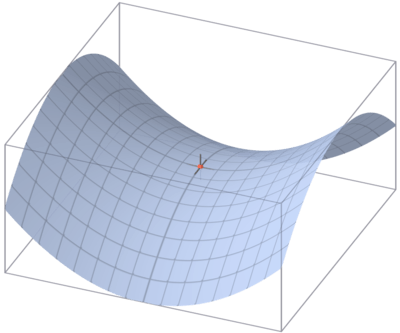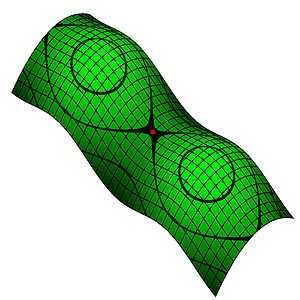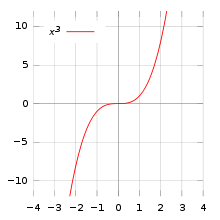Saddle point


 -contour)
-contour)In mathematics, a saddle point is a point in the domain of a function that is a stationary point but not a local extremum. The name derives from the fact that the prototypical example in two dimensions is a surface that curves up in one direction, and curves down in a different direction, resembling a saddle or a mountain pass. In terms of contour lines, a saddle point in two dimensions gives rise to a contour that appears to intersect itself.
Mathematical discussion
A simple criterion for checking if a given stationary point of a real-valued function F(x,y) of two real variables is a saddle point is to compute the function's Hessian matrix at that point: if the Hessian is indefinite, then that point is a saddle point. For example, the Hessian matrix of the function  at the stationary point
at the stationary point  is the matrix
is the matrix
which is indefinite. Therefore, this point is a saddle point. This criterion gives only a sufficient condition. For example, the point  is a saddle point for the function
is a saddle point for the function  but the Hessian matrix of this function at the origin is the null matrix, which is not indefinite.
but the Hessian matrix of this function at the origin is the null matrix, which is not indefinite.
In the most general terms, a saddle point for a smooth function (whose graph is a curve, surface or hypersurface) is a stationary point such that the curve/surface/etc. in the neighborhood of that point is not entirely on any side of the tangent space at that point.

In one dimension, a saddle point is a point which is both a stationary point and a point of inflection. Since it is a point of inflection, it is not a local extremum.
Other uses
In dynamical systems, if the dynamic is given by a differentiable map f then a point is hyperbolic if and only if the differential of ƒ n (where n is the period of the point) has no eigenvalue on the (complex) unit circle when computed at the point. Then a saddle point is a hyperbolic periodic point whose stable and unstable manifolds have a dimension that is not zero.
In a two-player zero sum game defined on a continuous space, the equilibrium point is a saddle point.
A saddle point of a matrix is an element which is both the largest element in its column and the smallest element in its row.
For a second-order linear autonomous systems, a critical point is a saddle point if the characteristic equation has one positive and one negative real eigenvalue.[1]
See also
- Saddle-point method is an extension of Laplace's method for approximating integrals
- Extremum
- First derivative test
- Second derivative test
- Higher-order derivative test
- Saddle surface
- Hyperbolic equilibrium point
- Sion's minimax theorem
- Mountain pass
- Max–min inequality
Notes
References
- Gray, Lawrence F.; Flanigan, Francis J.; Kazdan, Jerry L.; Frank, David H; Fristedt, Bert (1990), Calculus two: linear and nonlinear functions, Berlin: Springer-Verlag, pp. page 375, ISBN 0-387-97388-5
- Hilbert, David; Cohn-Vossen, Stephan (1952), Geometry and the Imagination (2nd ed.), New York: Chelsea, ISBN 978-0-8284-1087-8
- von Petersdorff, Tobias (2006), "Critical Points of Autonomous Systems", Differential Equations for Scientists and Engineers (Math 246 lecture notes)
- Widder, D. V. (1989), Advanced calculus, New York: Dover Publications, pp. page 128, ISBN 0-486-66103-2
- Agarwal, A., Study on the Nash Equilibrium (Lecture Notes)
